Let me start by saying this: if you’re in the market for a chainsaw sharpener, you’ve got options—tons of them. But when I stumbled across the Libiyi Chain Saw Sharpener, I was intrigued by its promises of speed, portability, and ease.
I mean, who doesn’t want a sharp chainsaw in seconds without breaking a sweat? Unfortunately, after digging into reviews and testing it myself, I can’t recommend you rush out to buy this one.
There’s too much smoke and mirrors here, and I’d hate for you to waste your hard-earned cash. Stick with me—I’ll walk you through my experience, the good, the bad, and what else is out there.
My Hands-On Experience With The Libiyi Chain Saw Sharpener
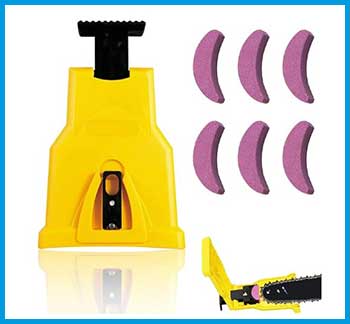
I’ve been using chainsaws for years—nothing professional, just keeping my backyard in check and tackling the occasional fallen branch after a storm. When my trusty old chain started dulling faster than I could sharpen it with a file, I figured it was time to try something new.
The Libiyi Chain Saw Sharpener caught my eye on Amazon with its sleek design and bold claims: “Sharpen your chain in 3-5 seconds!” and “Fits most chainsaws!” It sounded like a dream, especially since I’m not a fan of lugging heavy tools around or spending hours on maintenance.
So, I ordered it. The package arrived quickly, and I’ll give it this—it’s lightweight. I could toss it in my toolbox without a second thought. The sharpener itself is a simple setup: a plastic body with a grindstone inside, designed to clamp onto your chainsaw bar and sharpen the teeth as you pull the chain through. No batteries, no cords, just a manual squeeze-and-pull motion. I was excited to give it a whirl.
First problem? My chainsaw—a decent mid-range gas model—has a single-hole bar. The product description didn’t mention this, but the tiny slip of paper inside the box (calling it “instructions” is generous) said it only works with two-hole bars. I double-checked online, and sure enough, buried in the fine print, there it was. Strike one. I borrowed a friend’s two-hole saw to test it anyway because I’m stubborn like that.
With the right saw in hand, I clamped it on. The process was straightforward enough—line up the grindstone, squeeze, and pull the chain. It did sharpen the teeth, and I’ll admit, it was fast. Within a minute, my friend’s dull chain was cutting through a pine log better than before. But here’s where things went south: the clamp felt flimsy, like it might snap if I squeezed too hard. And after a few uses, the grindstone started wearing down unevenly. I wasn’t confident it’d hold up for more than a season.
Then there’s the fit issue again. Even on the two-hole saw, the alignment wasn’t perfect. The grindstone wobbled slightly, and I could tell it wasn’t hitting every tooth consistently. By the third sharpening session, I noticed the chain pulling to one side—never a good sign. Frustrated, I scoured reviews online and found I wasn’t alone. People were complaining about the same things: misleading compatibility, poor build quality, and no real instructions. I contacted customer service through Amazon, and while they offered a refund, I couldn’t shake the feeling I’d wasted my time.
Read More: My Thoughts on Arizona Tile Quartz In Your Life—Trust Me.
Pros Of The Libiyi Chain Saw Sharpener
Okay, let’s give credit where it’s due. The Libiyi Chain Saw Sharpener isn’t a complete disaster—it’s got some redeeming qualities if you’re in the right situation. Here’s what I liked about it, based on my experience and what others have said.
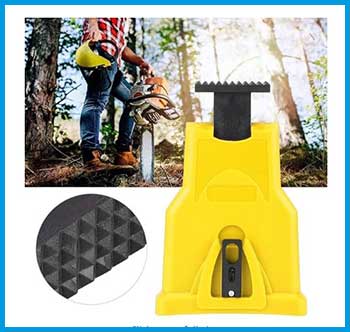
- Lightning-Fast Sharpening (When It Works) : When I got it lined up on my friend’s two-hole saw, the speed was impressive. I’m talking 3-5 seconds per tooth, just like they promised. Compared to the 10-15 minutes I’d spend with a file, it felt like a miracle. If you’ve got a compatible saw and just need a quick touch-up, this thing can save you time. I saw clean cuts on softwood right after sharpening, which was satisfying.
- Portability That Fits Your Life: This sharpener weighs next to nothing—maybe a pound at most. I could carry it in my pocket if I wanted to, which is a huge plus for anyone working outdoors. No cords or batteries mean you’re not tethered to a power source, and it’s small enough to stash in your chainsaw case. For someone who’s always on the move, like a camper or a weekend warrior, that’s a big win.
- Hands-Off Safety: I’ll admit, I liked not having to touch the grindstone. With a file, my hands are right there, risking a slip and a nasty cut. The Libiyi keeps your fingers out of the danger zone—you just clamp it on and let the tool do the work. That peace of mind is worth something, especially if you’re new to chainsaw maintenance.
- Affordable Price Point: At first glance, the price seemed reasonable—cheaper than a lot of electric sharpeners or high-end manual jigs. For under $20 (depending on where you buy), it’s not a huge investment. If it worked flawlessly, I’d call it a steal. But as you’ll see, you might get what you pay for here.
Cons Of The Libiyi Chain Saw Sharpener
Now, let’s talk about why I’m not singing this thing’s praises from the rooftops. The downsides piled up fast, and they’re deal-breakers for me—and probably for you too.
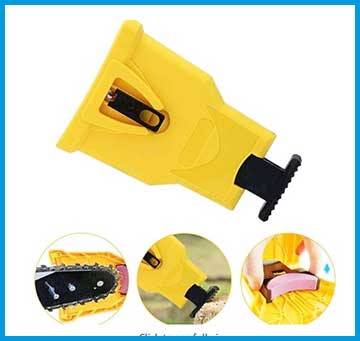
- Compatibility Nightmares: The biggest headache? It only works with two-hole chainsaw bars. My single-hole saw was useless with it, and I’m not alone—tons of reviews mention this. The product description conveniently skips over that detail, leaving you to figure it out after it arrives. If your saw doesn’t match, you’re out of luck. And even with a two-hole bar, the fit wasn’t always secure, which messed with the sharpening precision.
- Flimsy Build Quality: This thing feels cheap. The plastic clamp creaked under pressure, and I was paranoid it’d break mid-use. The grindstone wore down faster than I expected, too—after a few sharpenings, it was already losing its edge. For something that’s supposed to last, it didn’t inspire confidence. Other users online called it “trash” or said it fell apart, and I get it.
- No Instructions, No Guidance: I’m not exaggerating when I say the “instructions” were a joke—a single sentence on a scrap of paper. No diagrams, no tips, nothing. If you’re a beginner, good luck figuring out how to position it or troubleshoot wobble. I muddled through because I’ve sharpened chains before, but for a newbie? It’s a recipe for frustration.
- Inconsistent Results: Even when it worked, the sharpening wasn’t uniform. Some teeth came out razor-sharp, others barely improved. That wobbly grindstone I mentioned? It’s the culprit. A chain that pulls to one side is dangerous and inefficient—I’d rather spend extra time with a file than deal with that. Reviews echoed this: “It didn’t fit my saw, and the results were patchy.”
- Misleading Marketing: The ads hype it up as a universal fix for all chainsaws—12 to 22 inches, gas or electric, you name it. But the reality? It’s picky as hell. The “zero, one, or two holes” claim floating around some listings is flat-out wrong, and people were pissed when they found out. I felt duped, and you might too.
Maintenance Tips For The Libiyi Chain Saw Sharpener
If you’ve already got this sharpener—or you’re still tempted to try it—here’s how to keep it in fighting shape. I learned these tricks the hard way, and they might save you some grief.
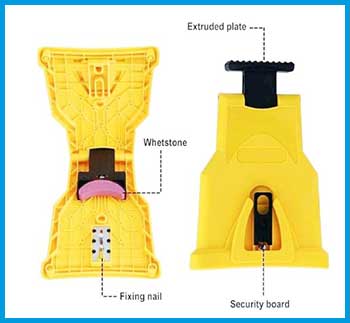
- Clean It After Every Use: Sawdust and metal shavings love to clog up the grindstone. After each session, I’d brush it off with an old toothbrush or blow it out with compressed air. It’s a small step, but it keeps the stone from gumming up and losing effectiveness. Don’t let debris sit there—it’ll wear the tool down faster.
- Check the Grindstone Regularly: That little stone is the heart of the sharpener, and it wears out quick. Before you start, give it a once-over. If it’s uneven or chipped, you’re not getting a good sharpen. I kept a spare on hand (some kits include extras), and swapping it out was easy—just unscrew and replace. Don’t push a worn stone too far; it’ll ruin your chain.
- Store It Dry and Safe: Moisture is the enemy of anything metal-adjacent. I kept mine in a dry toolbox, away from rain or damp sheds. The plastic might handle a little water, but the grindstone won’t thank you for it. Toss it in a ziplock bag if you’re taking it camping—just don’t let it rattle around loose and get banged up.
- Tighten the Clamp Gently: The clamp’s flimsy, so don’t go Hulk on it. I found a snug fit was enough—overtightening just stressed the plastic. Test it on your bar first, and if it slips, adjust slowly. You want it secure, not on the verge of cracking.
- Test on Scrap Wood First: Before tackling a big job, I’d sharpen and then cut a small log to check the chain. It saved me from realizing mid-project that the teeth were off. If it’s pulling or cutting slow, tweak the alignment and try again. Better to catch it early than wreck your chain—or your day.
Also read: My Thought on L’Brise Air Styler.
Comparing The Libiyi To Other Brands
Let’s stack the Libiyi up against some big names and see how it holds up. I’ve used a few sharpeners over the years, and I dug into what others say about these alternatives. Spoiler: Libiyi’s got some stiff competition.
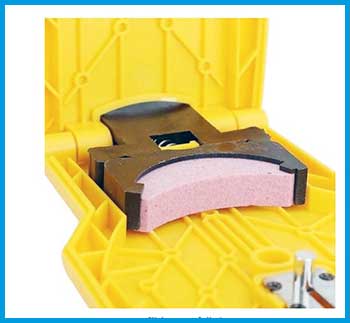
Libiyi vs. Oregon Compact Universal Sharpener
Oregon’s bench-mounted electric sharpener is a beast—precise, consistent, and built to last. I tried one at a buddy’s shop, and it turned a dull chain into a wood-slicing machine in minutes. It’s pricier (around $200) and needs power, so it’s not as portable as the Libiyi. But the results? Night and day. Oregon hits every tooth perfectly, while Libiyi’s hit-or-miss. If you’re serious about your saw, Oregon’s worth the splurge.
Libiyi vs. Stihl 2-in-1 Filing Guide
Stihl’s manual filing guide is my go-to for field touch-ups. It’s about $40, and it uses a round file and flat file together to sharpen teeth and set depth gauges. I love how it keeps angles consistent—something Libiyi struggles with. It’s slower than the Libiyi’s “3-second” promise, but the control is unmatched. Plus, it works on any chain, no hole nonsense. For hands-on folks, Stihl’s a better bet.
Libiyi vs. Granberg Bar-Mounted Sharpener
Granberg’s bar-mounted jig (around $35) is another manual option I’ve messed with. You clamp it to the bar and file away, guided by precise settings. It’s portable like the Libiyi, but way more durable—metal, not plastic. It took me 10 minutes to sharpen a chain, slower than Libiyi, but the evenness was spot-on. If you don’t mind a little elbow grease, Granberg outshines Libiyi in reliability.
Libiyi vs. Timberline Sharpener
The Timberline (about $100) is a premium hand-crank sharpener that some swear by. I haven’t owned one, but reviews rave about its carbide cutter and pinpoint accuracy. It’s portable and works on most chains, no power needed. Libiyi’s cheaper and faster, but Timberline’s build quality and consistency blow it out of the water. If budget’s not tight, Timberline’s a smarter pick.
Frequently Asked Questions (Faq)
I’d argue it depends on your needs, but the Oregon Compact Universal Sharpener gets my vote for overall performance. It’s electric, bench-mounted, and delivers razor-sharp chains every time. I’ve seen it in action, and it’s a pro-level tool. For portability, the Stihl 2-in-1 Filing Guide is tough to beat—simple, reliable, and works anywhere. The Libiyi? It’s not even in the running.
Sharpening’s usually the way to go—cheaper and keeps your chain going for dozens of uses. I sharpen mine until the teeth are too short or damaged (like after hitting a rock). A new chain’s $20-$40, while sharpening costs next to nothing if you’ve got a good tool. But if your chain’s trashed beyond repair, don’t waste time—replace it.
For me, a manual file with a guide—like Stihl’s 2-in-1—is the gold standard. It’s slow but gives you control over every tooth. Electric sharpeners like Oregon’s are faster and great for heavy users, though they need power. The Libiyi’s “squeeze and pull” idea sounded cool, but it’s too inconsistent. Stick to files or a solid electric option.
For hardwood, I aim for a 25-30-degree angle on the cutting teeth. It’s aggressive enough to bite into dense wood like oak without dulling too fast. Check your saw’s manual—most list the ideal angle (usually 25-35 degrees). With the Libiyi, I couldn’t control the angle, but a good file guide or electric sharpener lets you nail it every time.
Final Thoughts
After wrestling with the Libiyi Chain Saw Sharpener, I can’t tell you to buy it with a straight face. Sure, it’s got a couple of perks—fast sharpening and portability—but the cons outweigh them by a mile. Flimsy construction, compatibility headaches, and spotty results left me disappointed, and I’m not alone—bad reviews litter the internet. You deserve a tool that works without a fight, not one that’s a gamble. Spend a bit more on something like a Stihl guide or an Oregon electric sharpener, and you’ll thank yourself later. Trust me, your chainsaw (and your patience) will appreciate it.
